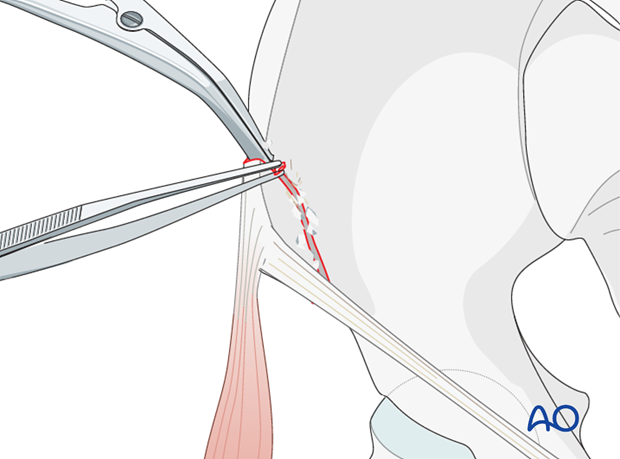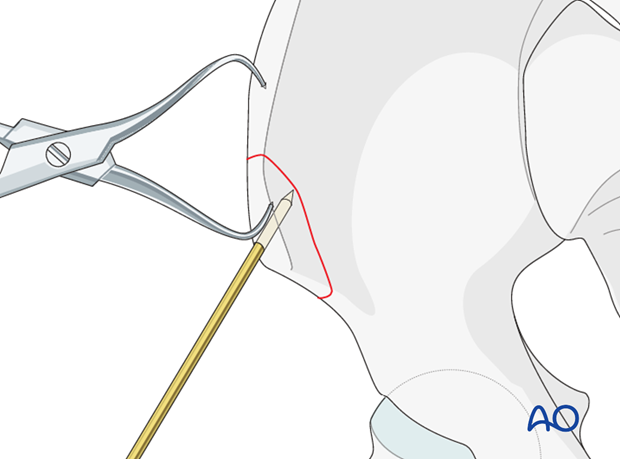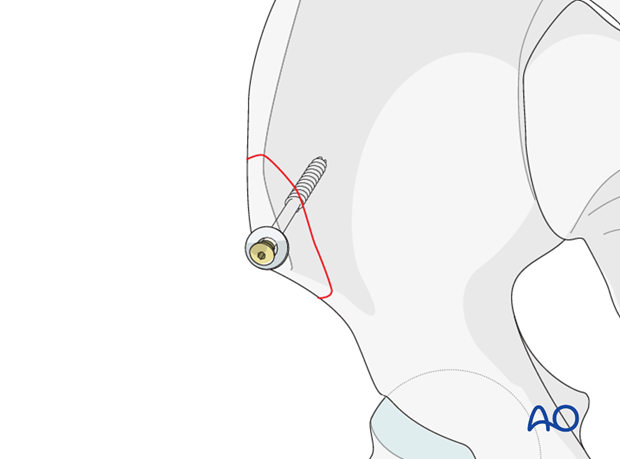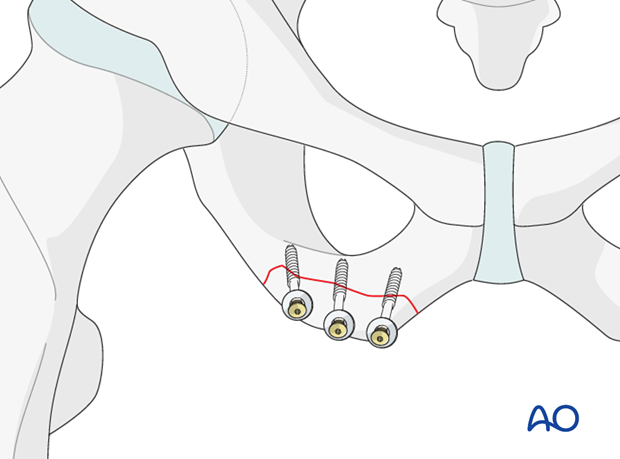ORIF - Apophyseal avulsion fracture
1. Introduction
These fractures are most common in young active people. They do not compromise the stability of the pelvic ring and are mainly treated conservatively with guided physiotherapy.
Indication for operative treatment is displacement larger than 1 – 2 cm, especially in young active athletes.
The most common avulsion fractures involve the anterior and inferior iliac spine. More rarely the symphysis and ischial tuberosity. The dislocation of the avulsed fragment always follows the direction of muscle contraction.
All these avulsions are treated in a similar fashion.

2. Reduction
Preparation of fracture site
The avulsed apophysis is exposed through an overlying incision. Typically, the anterior portion of an anterior iliac approach is used for anterior superior or inferior iliac spines. For an ischeal apophyseal avulsion, the patient is placed prone. A transverse sub-gluteal incision (along the gluteal crease) can be used to approach the site from its medial side. The sciatic nerve and posterior femoral cutaneous nerve are lateral and deeper than the tuberosity, and can be avoided or exposed if necessary.
The avulsion fracture is exposed with sharp and blunt dissection. Its muscle attachments are preserved. Displacement is increased if necessary with a lamina spreader or retractor, so the fracture surfaces can be cleaned of debris, interposed periosteum, and ligaments.

Reduction is performed using a small pointed reduction forceps together with a K-wire as a joystick.

Temporary fixation is achieved by further insertion of the K-wire.

3. Fixation
Preparation of fracture site
The fragment is fixed by insertion of a 3.5 mm half threaded cancellous screw inserted as a lag screw. A plastic pointed washer is used.
The screw should be inserted through the muscle attachment perpendicular to the fracture line.

In larger fragments (such as the ischial tuberosity), additional screws may be inserted.

X-rays
After completion of internal fixation, confirm the final reduction and hardware position intraoperatively by AP, inlet and outlet radiographic imaging.

4. Aftercare following open reduction and fixation
Postoperative blood test
After pelvic surgery, routine hemoglobin and electrolyte check out should be performed the first day after surgery and corrected if necessary.
Bowel function and food
After extensile approaches in the anterior pelvis, the bowel function may be temporarily compromised. This temporary paralytic ileus generally does not need specific treatment beyond withholding food and drink until bowel function recovers.
Analgesics
Adequate analgesia is important. Non pharmacologic pain management should be considered as well (eg. local cooling and psychological support).
Anticoagulation
Prophylaxis for deep vein thrombosis (DVT) and pulmonary embolus is routine unless contraindicated. The optimal duration of DVT prophylaxis in this setting remains unproven, but in general it should be continued until the patient can actively walk (typically 4-6 weeks).
Drains
Dressings should be removed and wounds checked after 48h, with wound care according to surgeon's preference.
Wound dressing
Dressings should be removed and wounds checked after 48h, with wound care according to surgeon's preference.
Physiotherapy
The following guidelines regarding physiotherapy must be adapted to the individual patient and injury.
It is important that the surgeon decide how much mechanical loading is appropriate for each patient's pelvic ring fixation. This must be communicated to physical therapy and nursing staff.
For all patients, proper respiratory physiotherapy can help to prevent pulmonary complications and is highly recommended.
Upper extremity and bed mobility exercises should begin as soon as possible, with protection against pelvic loading as necessary.
Mobilization can usually begin the day after surgery unless significant instability is present.
Generally, the patient can start to sit the first day after surgery and begin passive and active assisted exercises.
For unilateral injuries, gait training with a walking frame or crutches can begin as soon as the patient is able to stand with limited weight bearing on the unstable side.
In unstable unilateral pelvic injuries, weight bearing on the injured side should be limited to "touch down" (weight of leg). Assistance with leg lifting in transfers may be necessary.
Progressive weight bearing can begin according to anticipated healing. Significant weight bearing is usually possible by 6 week but use of crutches may need to be continued for three months. It should remembered that pelvic fractures usually heal within 6-8 weeks, but that primarily ligamentous injuries may need longer protection (3-4 months).
Fracture healing and pelvic alignment are monitored by regular X-rays every 4-6 weeks until healing is complete.
Bilateral unstable pelvic fractures
Extra precautions are necessary for patients with bilaterally unstable pelvic fractures. Physiotherapy of the torso and upper extremity should begin as soon as possible. This enables these patients to become independent in transfer from bed to chair. For the first few weeks, wheelchair ambulation may be necessary. After 3-4 weeks walking exercises in a swimming pool are started.
After 6 weeks, if pain allows, the patient can start walking with a three point gait, with less weight bearing on the more unstable side.
Full weight bearing is possible after complete healing of the bony or ligamentous legions, typically not before 12 weeks.













